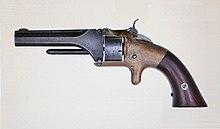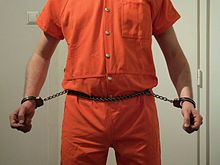Smith & Wesson
| Smith & Wesson
|
|
|---|---|
| legal form | Corporation |
| founding | 1852 |
| Seat |
Springfield , Massachusetts United States |
| management | P. James Debney |
| Number of employees | 1,453 (2008) |
| Branch | Weapons manufacturer |
| Website | www.smithandwesson.com |
The Smith & Wesson Corporation (S & W) is North America's largest manufacturer of handguns , based in Springfield ( Massachusetts ). The company is part of the American Outdoor Brands Corporation , a holding company based in Springfield (Massachusetts), USA.
Company history
The company was founded in 1852 by business partners Horace Smith and Daniel Baird Wesson under the name Smith & Wesson, Norwich , Connecticut .
After the partnership began in 1852, Horace Smith and Daniel Wesson developed and patented a magazine pistol, the predecessor of the Volcanic pistol (US Pat. 10535, Feb. 14 1854), metal cartridges (US Pat. 11496, Aug. 8, 1854) and the Volcanic Cartridge (US Pat. Jan. 1856) and began manufacturing Volcanic pistols and rifles . Due to financial difficulties and poor sales, they left their company in 1856. The Volcanic Repeating Arms Company was later transferred to Oliver Winchester from JW Post, a knife dealer . Winchester, founder of the later " Winchester Repeating Arms Company " continued to run the Volcanic Repeating Arms Company and had the Volcanic lever action rifles developed by B. Tyler Henry into the Henry Rifle .
The partners started a new company and began developing a revolver that could fire cartridges. Daniel B. Wesson had completed a wooden model of this revolver in August 1856 for firing his .22 short cartridge, the first of its kind for prefabricated metal cartridges. In November 1856, the partners met with Rollin White , the owner of the patent for cylindrically pierced revolver drums (Rollin White patent of April 3, 1855) and took it over for a royalty (25 cents per weapon). As early as 1857, the Smith & Wesson No 1 model, the first S&W revolver, came onto the market.
The timing of the development of cartridge revolvers proved to be beneficial because of the five years later erupting Civil War triggered a strong demand for "Smith & Wesson" products. After the end of the Civil War, Smith & Wesson was able to establish itself on the civilian market with its Model No 3 . With the Russian Model of Series No 3, the company even managed to deliver around 130,000 of this weapon to Tsarist Russia in the 1870s. With the introduction of a “safe” double action revolver in 1886, the company's triumphant advance was achieved.
The company experienced a further boom during the First World War , when delivery bottlenecks in handguns had to be compensated for. In 1964, the Wesson family sold the company to the Bangor Punta conglomerate . In 1984 this group and with it Smith & Wesson was taken over by the Lear Siegler Corporation. As a result, Smith & Wesson focused again on its core business and activities in other economic areas were discontinued. Lear Siegler was taken over again in 1986 and largely smashed. Smith & Wesson was sold to British conglomerate Tomkins plc for $ 112.5 million . In 2001, American investors around the safety lock manufacturer Saf-T-Hammer Corporation (now American Outdoor Brands Corporation) acquired the weapons manufacturer for 15 million dollars.
Products
The partners Smith & Wesson have mainly manufactured small arms ( revolvers , pistols ) and ammunition since the 1850s . A wide range of equipment for police and other security forces was later added: handcuffs, ankle cuffs and chains. Fishing rods and bicycles came from the company . Smith & Wesson products are considered to be of superior quality, safety, accuracy and durability.
The hinged revolvers
The Smith & Wesson Model 1 and 1 1/2 were the first series-produced revolvers by the company. (USA name: Tip up revolver ). To reload the barrel had to be opened and the empty casings removed with the ejector attached to the bottom of the barrel. The seven-shot model No. 1 in caliber .22 came on the market in January 1858. The first models had a frame made of brass, later they switched to steel. The five-shot model 1½ had a slightly larger frame. Constructively, it corresponded to Model No. 1 with a steel frame and, in contrast to this, fired ammunition in .32 caliber (7.9 mm).
The Smith & Wesson No. Revolver called 2 Army was a larger version of the Model 1½. As a six-shot army revolver with a barrel length of 6 inches (other barrel lengths 5 inches, rarely 8 and 10 inches), it was primarily acquired by participants in the American Civil War as a close-range defense weapon. A total of 77,155 copies were made between 1861 and 1874.
Revolver with a foldable barrel
The system of revolvers with a hinged barrel was unsuitable for mounted personnel to reload. For this reason, a revolver was developed in which the barrel and drum could be tilted for reloading in one unit, with the fired cases being ejected at the same time. To eliminate competition, Smith & Wesson acquired pre-existing patents for a barrel and barrel tilt system, a case ejection system, and a barrel rotation system. The patent protection applied for in the USA and the UK went to Charles A. King in 1869, the then operations manager at S & W and key developer of the Smith & Wesson No 3 revolver .
The first of the large-caliber single-action break-open revolvers (USA designation: top break revolver ) came on the market in May 1870. Later smaller models of these revolvers were also produced and from 1872 double-action models were also developed. The last Smith & Wesson double action break-open revolvers , pocket revolvers with concealed tap, were offered until 1937. Single-shot sport pistols in various calibers, mainly in .22 caliber, were produced on the frames of the single-shot revolvers between 1893 and 1923.
Revolver with swiveling drum
Towards the end of the 19th century, Smith & Wesson began developing revolvers with a one-piece, closed frame and screwed-in barrel. One of the reasons was the introduction of ammunition with smokeless powder and higher ballistic performance. The result was the still manufactured revolver with a side-swiveling drum, as it was developed by the Colt company in 1884. The drum was swiveled out for reloading. The empty tubes were ejected by hand by pushing back a pin located at the front end of the drum axle. Hence the name hand ejector .
- S & W Cal. .45 M1917 , (US service revolver in caliber .45 ACP and .45 Auto-Rim)
- S&W Model 27 and 28 .357 Magnum
- Smith & Wesson Model 25-2
- Model 12 Airweight
- Model 19 Combat Magnum (first light revolver in .357 Magnum caliber)
- Model .38 Chief's Special
- Smith & Wesson Model 29
- Model 547 (only revolver for 9 mm Luger cartridges)
- Smith & Wesson Model 460
- Smith & Wesson Model 500
- Model 686
- Smith & Wesson Model Governor (first revolver for three different calibers .45 ACP , .45 Colt and .410 shot )
| Frame label
Size description |
J-frame
(small) |
K-frame
(medium) |
L-frame
(medium-sized) |
N-frame
(big) |
X-frame
(very large) |
Z-frame
(Extended frame and drum) |
|---|---|---|---|---|---|---|
| caliber | .22 lfB
.22 Magnum .38 Special .357 Magnum |
.22 lfB
.22 Magnum .38 Special .357 Magnum |
.38 Special
9mm Luger .357 Magnum .44 Magnum |
.38 Special
9mm Luger .45 Colt .45 ACP .357 Magnum 10mm car .44 Magnum .44 S&W Special |
.45 Colt
.454 Casull .460 S&W Magnum .500 S&W Magnum |
.410 (shotshell)
.45 Colt .45 ACP |
| Models | S&W Model 36
S&W Model 43 S&W Model 60 S&W Model 63 S&W Model 317 S&W Model 340 S&W Model 351 S&W Model 360 S&W Model 442 S&W Model 637 S&W Model 638 S&W Model 640 S&W Model 642 S&W Model 649 |
S&W Model 13
S&W Model 17 S&W Model 19 S&W Model 48 S&W Model 66 S&W Model 617 |
S&W Model 686
S&W Model 69 S&W Model 986 |
S&W Model 25
S&W Model 27 S&W Model 29 S&W Model 57 S&W Model 58 S&W Model 325 S&W Model 327 S&W Model 329 S&W Model 610 S&W Model 625 S&W Model 627 S&W Model 629 S&W Model 929 |
S&W Model 460
S&W Model 500 |
S&W Model Governor |
Pistols
- Model 39 (USA's first double-action pistol)
- Model 1006 , pistol in caliber 10 mm car
- Model 1076 , pistol in the 10 mm caliber car
- Model 3913 , 9 × 19 mm caliber pistol
- Smith & Wesson (M1911 S&W) pistol in .45 ACP caliber
- Smith & Wesson Model SD9 VE , affordable entry-level pistol in caliber 9 × 19 mm
- Smith & Wesson Model SD40 VE , affordable entry-level pistol in .40 S&W caliber
tie up
Smith & Wesson manufactures various products for shackling prisoners and criminals, such as handcuffs , ankle cuffs and belly chains .
Web links
- The company's website (English)
Individual evidence
- ^ Smith & Wesson's growth has given new life to Houlton . In: Mainebiz . ( mainebiz.biz [accessed September 22, 2017]).
- ↑ Guenter K .: leg irons from the rest of the world. Retrieved May 29, 2017 .









